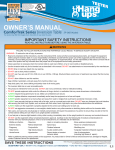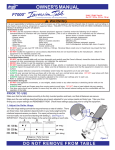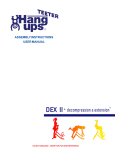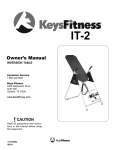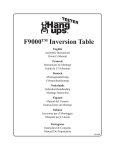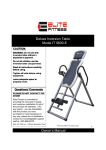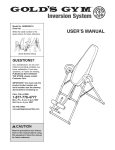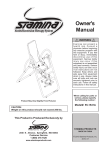Download User Manual
Transcript
This product is Listed by Underwriters Laboratories Inc. Representative samples of this product have been evaluated by UL and meet applicable safety standards. RATED 1 This product is Listed by Underwriters Laboratories Inc. Representative samples of this product have been evaluated by UL and meet applicable safety standards. R This product is Listed by Underwriters Laboratories Inc. Representative samples of this product have been evaluated by UL and meet applicable safety standards. OWNER’S MANUAL EP Series Inversion Tables This product is Listed by Underwriters Laboratories Inc. Representative samples of this EP-560, EP-560 Sport, EP-560 Ltd & EP-860 Your product may differ from images shown. Instructions forbeen useevaluated remain the same. product have by UL and meet applicable safety standards. IMPORTANT SAFETY INSTRUCTIONS READ ALL INSTRUCTIONS BEFORE USING THE INVERSION TABLE. ! WARNING FAILURE TO FOLLOW INSTRUCTIONS AND WARNINGS COULD RESULT IN SERIOUS INJURY OR DEATH. WARNING—To reduce the risk of injury to persons: • Read and understand all the instructions, review all other accompanying documents, and inspect the equipment before using the inversion table. It is your responsibility to familiarize yourself with the proper use of this equipment and the inherent risks of inversion, such as falling on your head or neck, pinching, entrapment, or equipment failure. It is the responsibility of the owner to ensure that all users of the product are fully informed about the proper use of the equipment and all safety precautions. • Close supervision is necessary when the inversion table is used near children, or by or near invalids or disabled persons. • Use the inversion table only for its intended use as described in this manual. DO NOT use attachments not recommended by the manufacturer. • NEVER drop or insert any object into any opening. • DO NOT use or store product outdoors. • DO NOT use if you are over 6 ft 6 in (198 cm) or over 300 lbs. (136 kg). Structural failure could occur or head/neck may impact the floor during inversion. • DO NOT allow children to use this machine. • Keep children, bystanders, and pets away from machine while in use. • Keep body parts, hair, loose clothing and jewelry clear of all moving parts. • The inversion table has no user serviceable parts. • This product is intended for home use only. DO NOT use in any commercial, rental or institutional setting. • DO NOT operate equipment while under the influence of drugs, alcohol, or medication that may cause drowsiness or disorientation. • ALWAYS inspect the equipment prior to use. Make sure all fasteners are secure. • ALWAYS replace defective components immediately and/or keep the equipment out of use until repair. • ALWAYS position equipment on a level surface and away from water or ledges that could lead to accidental immersion or falls. • ALWAYS wear securely tied lace-up shoes with a flat sole, such as a normal tennis style shoe. DO NOT wear any footwear that could interfere with securing the Ankle Lock System, such as shoes with thick soles, boots, high-tops or any shoe that extends above the anklebone. • ALWAYS make sure the equipment is properly adjusted to the correct user settings prior to each use. • DO NOT use aggressive movements, or use weights, elastic bands or any other exercise or stretching device while on the inversion table. • New users, and users who are physically or mentally compromised, will require the assistance of a partner to ensure they are able to find the correct balance setting and can return to an upright position unassisted. • If you feel pain or become light-headed or dizzy while inverting, immediately return to the upright position for recovery and eventual dismount. • DO NOT use the equipment without a licensed physician’s approval. Carefully review the following list of medical contraindications for inversion with your licensed physician: (This is not an exhaustive list, it is intended only for reference) · Middle ear infection · Glaucoma · Heart or circulatory disorders · Bone weakness (osteoporosis) · Extreme obesity · Retinal detachment · Spinal injury · Recent or unhealed fractures · Pregnancy · Conjunctivitis · Cerebral sclerosis · Medullary pins · Hiatal hernia · High blood pressure · Acutely swollen joints · Surgically implanted orthopedic supports · Ventral hernia · Hypertension · Recent stroke or transient · Use of anticoagulants ischemic attack (including high doses of aspirin) • Refer to additional warning notices posted on the equipment. If a product label or Owner’s Manual should become lost, damaged or illegible, contact Customer Service for replacement. SAVE THESE INSTRUCTIONS Specifications subject to change without notice. ©COPYRIGHT 2011; International law prohibits any copying. E6-1710 0711-0 QUESTIONS? USA: 1-800-847-0143, [email protected] International: +1-242-362-1001, [email protected] 1.1 BEFORE YOU INVERT make sure that the inversion table rotates smoothly to the fully inverted position and back, and that all fasteners are secure. Make sure the user settings described below are properly adjusted for your unique needs and body type. Take your time finding your proper settings and remember them. Check these settings every time prior to using the equipment. Ready for use A B C Roller Hinges: Find Your Setting The Roller Hinges control the responsiveness or rate of rotation. There are three holes; the hole selection depends both on your Bed rotated for adjusting the body weight and the rotational responsiveness you desire Roller Hinge Setting (diagram below). For users just learning to use the inversion table, we recommend starting with Setting C (Figure 1), the least responsive rotation setting. Roller Hinge Selection Per User Weight A Top (closest to Pivot Pin) Most Responsive Setting B C Bottom (furthest from Pivot Pin) Middle Least Responsive Moderately Responsive 80 - 120 lbs. (36 - 54 kg.) 120 - 220 lbs. (54 - 100 kg.) 220 - 300 lbs. (100 - 136 kg.) Beginner / Partial Inversion IMPORTANT: Set the Roller Hinges in the same hole setting on each side. Refer to Adjustments: Changing the Roller Hinge Setting in the assembly instructions. Figure 1 Suggested for Full Inversion Height Setting: Adjust the Main Shaft The height settings are labeled on the Main Shaft in both inches and centimeters. • Pull out the Height-Selector Locking Pin with your right hand while sliding the Main Shaft with your left (Figure 2). • Slide the Main Shaft until the last setting you can read is one inch greater than your height. e.g. If you’re 5’10” (178 cm) the last numbers you’ll be able to read will be 5’11” (180 cm). NOTE: The best height setting for you will depend on your weight distribution and could vary one or two inches on either side of your actual height. Starting at one or two inches more than your height will help to ensure that the rotation of the table is not too fast. • Release the Height-Selector Locking Pin so that it fully engages in a hole. Figure 2 Angle Tether: Adjust to Desired Angle For first time users, attach the Angle Tether to the U-Bar under the Table Bed (Figure 3) to help control your angle of rotation. You can increase the angle of rotation allowed by the Angle Tether as you become more comfortable using the table, or remove it for full inversion. Ankle Comfort Dial: Find Your Setting Figure 3 The Ankle Comfort Dial can rotate into a High or Low setting (Figure 4). There is a one inch height difference between the settings. The setting you select will vary by the type of shoes you wear and your ankle type. Try inverting in both settings to determine which one is most comfortable for you. The Ankle Comfort Dial should be set so the Front Ankle Cups and Heel Cups are secure around the smallest part of the ankles (with minimal distance between the Ankle Lock System and the top of your foot); this will reduce sliding on the Table Bed while inverted. Prepare to Mount • ALWAYS wear securely tied, lace up shoes with a flat sole, such as a tennis shoe. • DO NOT wear shoes with thick soles, boots, high-tops or any shoe that extends above the ankle bone, as this type of footwear could interfere with properly securing your ankles. Figure 4 R 1.2 Securing Your Ankles Figure 5 Figure 6 Figure 7 • Stand with your back to the Table Bed—do not use the inversion table face-down. • Step over the Main Shaft, placing your feet on the floor on either side. To balance yourself, rest only your lower body against the Table Bed as you slide one ankle at a time between the Front Ankle Cups and the Heel Cups, placing your feet on the Ankle Comfort Dial. • Be sure to slide your ankle in from the side (Figure 5); DO NOT insert your foot as you would slide your foot into a shoe. Your feet should always be either on the floor or on the Ankle Comfort Dial; never use any other part of the inversion table as a step (Figures 6 and 7). • Press your ankles back firmly against the Heel Cups. • Rotate the top of the Heel Cups toward your ankles to increase comfort while inverting. • Pull the T-Pin Lock out to allow the Front Ankle Cups to snap closed against your ankles (Figure 8). • Adjust the Front Ankle Cups and Heel Cups to ensure the Ankle Lock System fits snugly against your ankles. Release the T-Pin Lock so that it fully engages in a hole setting (Figure 9). • If the T-Pin Lock does not automatically engage in a hole (Figure 10), push the Front Ankle Cups toward you until the pin engages fully in the next tightest hole setting. • Verify that no part of your footwear or garments touch or interfere with the T-Pin Lock in any way during inversion. • Use the concept of HEAR, FEEL, SEE every time you secure your ankles: HEAR the T-Pin Lock click into place; FEEL the T-Pin Lock to make sure it is fully engaged in a hole setting; SEE that there is NO space between the T-Pin Lock and its base. ! WARNING DO NOT lean your upper body against the Table Bed before securing your ankles. FAILURE to engage the T-Pin Ankle Lock System fully could result in serious injury or death! DO NOT deviate from these instructions. Test Your Balance Setting Figure 8 Figure 9 The inversion table is sensitively balanced, and it responds to very small changes in weight distribution. As a result, you must always test to make sure you have the correct height setting. Ensure that there is clearance to rotate in front, above and behind you. To begin, rest your head on the bed and slowly place your arms on your chest. • If your head is lower than your feet, lengthen the height setting by one hole and test again. • If your feet do not move at all, shorten the height setting by one hole and test again. • If the table comes to rest with your feet lifted a few inches off the A-frame, then you have found the correct balance setting. This is an important step—spend the time needed to find your correct balance setting. Your setting should remain the same as long as your weight does not fluctuate substantially. ! WARNING For your first few inversion sessions, ask a spotter to assist you until you are able to find your correct balance setting and are comfortable with the operation of the table. Figure 10 R 1.3 Inverting When correctly balanced, the inversion table will rotate in response to simple arm movements. To invert, lift your arms overhead slowly and to return upright, bring your arms back to your sides. Your arms provide the weight needed to rotate the table. (Figure 11). To ensure the inversion table does not rotate too far, too quickly: • Set the Roller Hinges to Setting “C” (as explained on pg. 2); • Attach the Angle Tether to the underside of the table and test to maximum rotation; • Raise one arm at a time, and do so very slowly (the faster you move, the faster the inversion table will rotate). Figure 11 Returning Upright To return to the upright position, put your arms at your sides. Since your body may have lengthened or shifted on the Table Bed during inversion, you may need to bend your knees to shift your body weight to the foot side of the pivot point. DO NOT lift your head or try to sit up (Figure 12). Full Inversion Definition: Hanging completely upside down by your ankles with your back free from the table. DO NOT attempt this step until you are comfortable with partial inversion. Figure 12 ! WARNING To reduce tipping hazard, confine all inverted activities to smooth movements. Aggressive exercises that involve vigorous body movement can cause the table to tip over, resulting in serious injury or death! • Disconnect the Angle Tether. • Set the Roller Hinges in the top hole setting “A” if you want the table to “lock” firmly while inverted. If you are 220 lbs (100 kg) or more, set the Roller Hinges in the “B” hole setting. • Slowly raise both hands over your head to begin rotation. You may need to assist the last few degrees of rotation by pushing on the floor or A-frame until the Table Bed pulls away from your back (Figure 13). • In your correct balance setting, your weight will keep the Table Bed “locked” in this position until you are ready to return upright. To Release from the Inverted “Locked” Position: • With one hand, reach behind your head and grasp the Table Bed and Bed Frame Extension (Figure 14). With the other hand, grasp the base of the A-frame in front of you. • Pull both hands together (Figure 15). This will rotate the Table Bed out of the “locked” position. Slowly move your arms and elbows to your sides to complete the rotation. USE CAUTION: Elbows protruding over the sides of the Table Bed could get pinched between the A-frame and the Table Bed as you return upright (Figure 16). Figure 13 Figure 14 ! WARNING It is your responsibility to familiarize yourself with the proper use of the equipment and the inherent risks of inversion, such as falling on your head or neck, pinching, entrapment or equipment failure. DO NOT use the inversion table until you have thoroughly and carefully read the Owner’s Manual, reviewed all accompanying documents and inspected the equipment. Figure 15 ALWAYS test and inspect the equipment for smooth operation prior to each use. Figure 16 R 1.4






